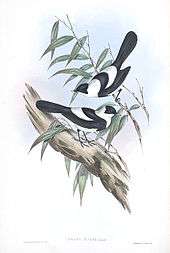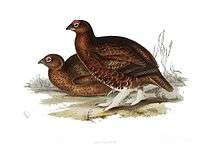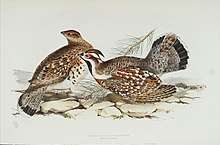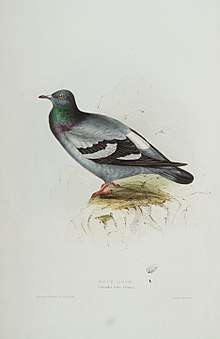Elizabeth Gould (illustrator)
Elizabeth Gould, née Coxen (1804—1841), was a British artist and illustrator, married to naturalist and author John Gould. She produced many illustrations and lithographs for ornithological works, including plates in Darwin's The Zoology of the Voyage of H.M.S. Beagle and the Goulds' seminal work The Birds of Australia.
Elizabeth Gould | |
|---|---|
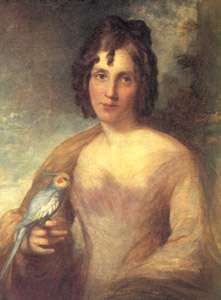 | |
| Born | Elizabeth Coxen 18 July 1804 Ramsgate, England |
| Died | 15 August 1841 (aged 37) |
| Nationality | British |
| Spouse(s) | John Gould |
Life and artistic career
Elizabeth was born on 18 July 1804 in[1] Ramsgate, England to a military family. Elizabeth likely underwent training in drawing and botany from an early age as was typical of a woman of her class in Victorian England. She met John Gould through her brother, Charles Coxen, who was also an taxidermist.[2] She married John Gould in January 1829, both 24 years old. Elizabeth began her professional work-life by producing ornithological drawings intended to supplement John's ornithological writing in letters to colleagues. John encouraged her to learn lithography and asked his collaborator Edward Lear to teach her. The extent of Lear's direct influence on the artist is uncertain, but they moved in a circle of artists and natural historians working on similar publications. All of this group were enthused with the depiction and scientific illustration of the unknown animals found on European expeditions, especially the novelties in English collections of Australian birds and mammals.[3] Once proficient with the art form, she created illustrations from John's more rudimentary drawings.[4] She designed, lithographed, and painted more than 650 plates[2] which appeared in:
- A Century of Birds from the Himalaya Mountains (1831 and 1832). 80 plates. For this book, she worked with taxidermied birds.
- The Birds of Europe (1832–37). 380 plates. For this book, live (caged) birds were available for her reference. This is when her signature style of ornate backgrounds and realistic shading were first realized. Lithography allowed for more realistic textures, such as feathers and fluff.
- A Monograph of the Ramphastidae, or Family of Toucans (1834). 24 plates.
- A Monograph of the Trogonidae, or family of trogons (1835–38). Most of the 36 plates.
- The Zoology of the Voyage of H.M.S. Beagle, pt. III. Birds (1838). Gould created all 50 plates for this work but is uncredited.[2]
- A Synopsis of the Birds of Australia (1837–38).120 plates.
- The Birds of Australia (1837–38). 84 plates, as well as an unspecified number of designs. This was the Gould's biggest and most ambitious project. Elizabeth sketched these subjects alive. Her most famous work is an image of the fairy wren (then known as the blue warbler).
- The Birds of Australia (1840-48). Many of the 681 hand-coloured plates prepared by Gould have been digitised by the State Library of New South Wales.[5]
- Icones avium, or, Figures and descriptions of new and interesting species of birds from various parts of the globe (1837–38). 20 plates.
_(9240055086).jpg)
_(9239994388).jpg)
Her early illustrations have been described as stiff, but subsequently improved with experience.[6] They remained quite formal compositions due to their use in ornithological classification.[7][8]
The Goulds and the oldest of their surviving 4 children travelled to Australia in 1838. Elizabeth spent much of her time in Hobart as a guest of Jane Franklin. While John travelled extensively collecting specimens, Elizabeth drew and painted specimens. Her brother Charles Coxen also immigrated to Australia, where he and his wife Elizabeth Coxen, who were also interested in natural history, became members of the Queensland Philosophical Society.
While in Australia, Elizabeth made hundreds of drawings from specimens for the publications Birds of Australia and A Monograph of the Macropodidæ, or Family of Kangaroos, as well as illustrations for the ornithology volume of Charles Darwin’s Zoology of the Voyage of HMS Beagle.[9]
She bore one son while living in Australia, and gave birth to their eighth child when they returned to England in 1840.[note 1] She died shortly thereafter.
Gould completed 84 plates for The Birds of Australia before her death. Many of the drawings and designs she produced in Australia informed the work of H. C. Richter, who completed the illustrations for The Birds of Australia.[2][10]

A complete account of her life, The Story of Elizabeth Gould, was published by Alec Chisholm in 1944. Little was known about her until 1938 when a collection of her letters written from Australia was discovered. These letters were the basis for the book. Now housed in the Mitchell Library, the letters reveal her as a charming, cultured, and musically and artistically talented woman. Although the Goulds spent less than two years in Australia, the monumental seven-volume publication The Birds of Australia remains the definitive work on the subject.
The Gouldian finch (Chloebia gouldiae) and Mrs. Gould's sunbird (Aethopyga gouldiae) were named in her honour.
Attribution and contemporary scholarship
There is a growing body of critical research exploring the attribution of Elizabeth's work to her husband.[11] His own role in producing the lithographs has been questioned and examples of his style of drawing have been submitted to suggest that the actual drawing and coloring is likely the sole work of Elizabeth.[6] Her role as sole artist of their first collection A Century of Birds from the Himalaya Mountains was acknowledged on every lithograph with the attribution "Drawn from Nature and on Stone by E. Gould." Subsequent collections used "J & E Gould." The Birds of Australia includes a number of attributions to "J & E Gould." However, scholars feel that Elizabeth's exhaustive work creating an archive of preparatory drawings for the lithographs before her death was not adequately recognized.[2][11]
Portrayals in popular media
- Melissa Ashley, The Birdman's Wife, Affirm Press, 2016, historical fiction.[12] In the 2017 Queensland Literary Awards, the novel won the University of Queensland Fiction Book Award.[13]
Gallery
See also
Notes
- Only 6 of the Gould's children survived to adulthood.
References
- Chisholm, A. H. "Gould, Elizabeth (1804–1841)". Australian Dictionary of Biography. National Centre of Biography, Australian National University. Archived from the original on 2018-10-24. Retrieved 2019-06-10 – via Australian Dictionary of Biography.
- "Elizabeth Gould · John Gould: Bird Illustration in the Age of Darwin · KU Libraries Exhibits". exhibits.lib.ku.edu. Archived from the original on 2018-10-24. Retrieved 2018-12-27.
- Peck, R. McCracken (2006). The natural history of Edward Lear (1812-1888). Suffolk: ACC art books. pp. 15, 71–72. ISBN 9781851498307.
- Australian Museum. Elizabeth Gould Archived 2006-09-01 at the Wayback Machine
- "Splendid species" (PDF). SL Magazine. 11 (1): 4–5. Autumn 2018. Archived (PDF) from the original on 2019-04-04. Retrieved 2019-06-10.
- "Women's Work". Linda Hall Library. 2005. Archived from the original on 2017-03-27. Retrieved 24 October 2018.
- A. H. Chisholm, Gould, Elizabeth (1804 - 1841) Archived 2007-02-14 at the Wayback Machine, Australian Dictionary of Biography, Volume 1, Melbourne University Press, 1966, p. 465.
- Russel, Roslyn (2011). The Business of Nature: John Gould and Australia. Canberra: National Library of Australia.
- Linda Hall Library. Portraits of 12 Scientific Illustrators from the 17th to the 21st Century Archived 2017-03-27 at the Wayback Machine
- "Splendid Species". State Library of NSW. 2017-12-08. Archived from the original on 2018-12-28. Retrieved 2018-12-28.
- Ashley, Melissa (2014). "Elizabeth Gould, zoological artist 1840-1848: Unsettling critical depictions of John Gould's 'laborious assistant' and 'devoted wife'". Hecate. 39 – via Informit.
- Johnston, Dorothy (November 4, 2016). "Review: The Birdman's Wife by Melissa Ashley and The Atomic Weight of Love by Elizabeth J Church". Sydney Morning Herald. Archived from the original on 2017-05-16. Retrieved 1 May 2017.
- "Winners and finalists". Queensland Literary Awards. 2017. Archived from the original on 9 October 2017. Retrieved 9 October 2017.
Further reading
- Newman, Alexandra K. "Elizabeth Gould: An Accomplished Woman." Unbound: Smithsonian Libraries.
- Russell, Roslyn (June 2009). "Elizabeth Gould: 'mother' of Australian bird study" (PDF). The National Library Magazine. 1 (2): 8–11. Retrieved 17 January 2011.
- Chisholm, A.H. (1944) The story of Elizabeth Gould
- Gould, E. Mrs Elizabeth Gould collection of drawings of Australian plants, flowers and foliage, 1838-42
External links
| Wikimedia Commons has media related to Elizabeth Gould. |



